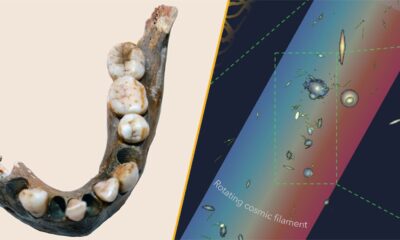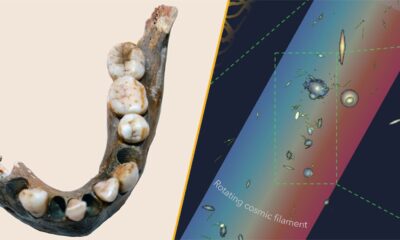Science
Researchers Illuminate Quasicrystal Mysteries After 40 Years

In a remarkable advancement for materials science, a team of researchers has made a significant discovery regarding quasicrystals, a unique class of structures that have puzzled scientists for over four decades. This breakthrough not only clarifies longstanding questions surrounding quasicrystals but also hints at potential new applications across various industries.
Understanding Quasicrystals
Quasicrystals are materials that exhibit an order distinct from traditional crystals. Unlike conventional crystals, which possess a repeating pattern that uniformly fills space, quasicrystals feature an ordered structure without periodicity. This characteristic allows them to display symmetries, such as five-fold symmetry, that are typically forbidden in classical crystallography. The first naturally occurring quasicrystal, identified in 1984 within a mineral called icosahedrite, laid the groundwork for understanding these materials. It was not until 2009 that laboratory-created quasicrystals were successfully demonstrated, revealing their exceptional properties, including remarkable hardness and low friction.
The Recent Breakthrough
The latest discovery stems from a collaboration between the Institute of Advanced Materials Research (IAMR) and several universities. Utilizing cutting-edge imaging techniques and computational modeling, the researchers traced the atomic structure of a specific quasicrystal for the first time. This analysis unveiled the arrangement of atoms and the principles regulating its formation.
One of the most intriguing findings was the quasicrystal’s ability to respond dynamically to external stimuli, challenging the previous notion that these structures are static. “This means that quasicrystals can change their properties and structures under certain conditions, which dramatically broadens the possibilities for their application,” stated Dr. Maria Chen, the lead researcher.
The implications of this discovery extend far beyond academic curiosity. The enhanced understanding of quasicrystal dynamics could pave the way for innovative materials that adapt and respond to their environments. Potential applications include advanced coatings that reduce wear and tear, improved materials for electronics, and even advancements in aerospace engineering.
Moreover, the biomedical sector is taking interest due to the non-toxic nature of quasicrystals. Their unique surface characteristics make them promising candidates for use in medical implants and devices.
While the excitement surrounding these findings is palpable, challenges remain. Fully grasping the rules governing quasicrystals presents a complex hurdle, and their production often requires controlled conditions that may not be feasible for large-scale manufacturing. Nevertheless, this recent discovery offers a roadmap for further exploration and application of these fascinating structures.
As researchers continue to decode the mysteries of quasicrystals, the field of materials science stands on the verge of a new frontier. This breakthrough not only clarifies decades of inquiry but also suggests a promising future for innovative applications that could transform multiple industries. The journey into the intricate world of quasicrystals is far from complete, and it is anticipated that this research will inspire a wave of new discoveries in the coming years.
-

 Technology5 months ago
Technology5 months agoDiscover the Top 10 Calorie Counting Apps of 2025
-

 Health3 months ago
Health3 months agoBella Hadid Shares Health Update After Treatment for Lyme Disease
-

 Health3 months ago
Health3 months agoErin Bates Shares Recovery Update Following Sepsis Complications
-

 Technology4 months ago
Technology4 months agoDiscover How to Reverse Image Search Using ChatGPT Effortlessly
-

 Technology1 month ago
Technology1 month agoDiscover 2025’s Top GPUs for Exceptional 4K Gaming Performance
-

 Technology3 months ago
Technology3 months agoElectric Moto Influencer Surronster Arrested in Tijuana
-

 Technology5 months ago
Technology5 months agoMeta Initiates $60B AI Data Center Expansion, Starting in Ohio
-

 Technology5 months ago
Technology5 months agoRecovering a Suspended TikTok Account: A Step-by-Step Guide
-

 Health4 months ago
Health4 months agoTested: Rab Firewall Mountain Jacket Survives Harsh Conditions
-

 Lifestyle5 months ago
Lifestyle5 months agoBelton Family Reunites After Daughter Survives Hill Country Floods
-

 Health3 months ago
Health3 months agoAnalysts Project Stronger Growth for Apple’s iPhone 17 Lineup
-

 Technology4 months ago
Technology4 months agoHarmonic Launches AI Chatbot App to Transform Mathematical Reasoning




















